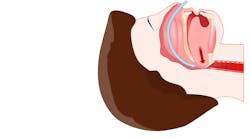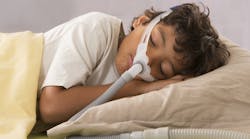3 reasons dentists should offer oral appliance therapy, not night guards, for sleep apnea
"I’m in so much pain! I think I broke a tooth!" This is the type of weekend emergency call I receive often. The patient comes into the office on Monday, and sure enough, their molar is fractured. After taking a PA, the tooth is restorable, and I recommend full or partial coverage.
But a few months later, that same patient is back with another broken tooth on the opposite side. In addition to the fractures, I notice grinding wear on the anterior teeth, no canine guidance, and no anterior disclusion. I suggest a night guard for protection. It's the common solution, but is it the right one?
In another example, a patient wakes up with severe headaches, pain near their ears, and difficulty opening their mouth. A thorough evaluation reveals they’re suffering from a TMJ disorder. Based on my training, a night guard is typically the next step. But after discussing their sleep habits—snoring, gasping for air, nonrestorative sleep, and daytime fatigue—I’ve come to an important realization: these symptoms often point to a deeper issue, such as sleep-disordered breathing, particularly obstructive sleep apnea (OSA).1
Here’s the truth: night guards may be making the problem worse. Addressing sleep apnea can solve both the TMJ pain and the damage from teeth clenching or grinding.1 Here I share three secrets to help you understand why offering oral appliances for sleep apnea is a better solution than night guards alone.
Secret 1: The signs of sleep-disordered breathing are right in front of us
As dentists, we’re often the first to notice signs of sleep-disordered breathing in patients. Bruxism, worn-down teeth, and TMJ symptoms can indicate an underlying airway problem. While night guards may protect teeth, they don’t address the root cause, and in some cases may even exacerbate airway issues by occupying valuable tongue space.
A practical way to screen for sleep-disordered breathing is by observing oral markers.2 I use the acronym NESTS, which was described by Lauren Gueits, founder of Airway Health Solution, during an interview on my YouTube channel, "Sleep apnea: Breathing, snoring help."
NESTS means narrow arches; enlarged tonsils/adenoids; soft palate elongated/uvula swollen from snoring; tethered oral tissues such as frenum; and scalloped tongue.
This simple framework helps identify potential airway issues during routine exams. Dr. Steven Lamberg, author of Treat the Cause, Treat the Airway, and Angie Richwine, founder of Central Virginia OMT, director of operation for Airway Circle, developed the acronym SWALLOWS: strain on perioral muscles during swallowing; width of the palate; airway mode—oral or nasal; lymphoid tissues—tonsils/adenoids; ocular signs—venous pooling under the eyes; wear on teeth; and scalloped tongue.
This comprehensive tool is another excellent way to assess airway health. Opening the conversation about sleep apnea can be challenging, but I've found success introducing patients to the SnoreLab app. By recording their snoring at night, patients gain insight into potential sleep disruptions. This data helps initiate a discussion about further evaluations. Dentists who see patients every three to six months have the unique opportunity to screen for these issues early. Our entire team can support patient education around the importance of airway health.
Secret 2: Oral appliance therapy treats the root cause, while night guards may worsen sleep apnea
Many dentists, including me, were trained to prescribe night guards for TMJ pain or bruxism. However, research shows that bruxism is often the body’s way of compensating for a blocked airway during sleep. The muscles work to push the lower jaw forward, trying to keep the airway open. Night guards, while protecting the teeth, occupy tongue space, potentially worsening the airway obstruction.3
On the other hand, oral appliance therapy (OAT), which moves the jaw into a more forward position, can help open the airway and reduce symptoms of sleep apnea, including bruxism. According to the American Academy of Sleep Medicine (AASM), oral appliances are a first-line treatment for patients with mild to moderate sleep apnea (AHI [Apnea-Hypopnea Index] between 5–30).4 For severe cases, OAT can be an alternative when CPAP is not tolerated due to issues such as insomnia or claustrophobia.
By treating the underlying cause—sleep apnea—we can offer patients a more comprehensive solution that protects their teeth and improves their overall health, reducing risks of heart disease, high blood pressure,5 depression, and diabetes. Dentists can save lives by controlling sleep apnea to decrease the risk of stroke or heart attack.6
Secret 3: Mastering dental sleep medicine improves your practice and patient outcomes
How do you make the shift from offering night guards to treating sleep apnea? The landscape of dental sleep medicine can seem challenging, but it’s incredibly rewarding for your patients and practice. Here’s how to get started.
Training: Dentists need the proper skills to recognize the signs of sleep-breathing disorders. Dr. Dave Federici, diplomat of AADSM and educator of AADSM mastery course, said, "Understanding the mechanics of sleep-disordered breathing and how it manifests in the mouth is key to making the right treatment decisions. Dentists need to educate themselves through programs like the AADSM mastery course to provide optimal care."
Building medical collaborations: One challenge is that dentists cannot diagnose sleep apnea without collaborating with medical professionals. Develop relationships with sleep physicians or primary care doctors who can refer patients for sleep studies (either home sleep studies or lab-based studies). Dr. Nishi Bhopal, founder of Intrabalance, said, “I would be very interested to work with dentists. That can be mutually beneficial and improve patient care.”
Once diagnosed, you can offer oral appliance therapy, as long as the patient’s physician provides a referral. In our office, we follow up on the sleep study results and discuss them with the patient to ensure continuity of care. Tell your medical collaborators that for mild to moderate sleep apnea, OAT is a viable first-line treatment, according to AASM guidelines. Dr. Valerie Cacho, founder of Sleephoria, said, “For patients who cannot tolerate CPAP, an oral appliance can be a lifesaver.”
Financial benefits: Many dentists hesitate to embrace dental sleep medicine due to concerns about insurance reimbursement. But there are options. Dentists can become Medicare providers and bill out-of-network medical insurance for oral appliances. Jon Nierman, president of Dental Writer, a medical billing software company, points out that with proper documentation, dentists can receive reimbursement for OAT. Also, there are billing companies that specialize in medical insurance claims for this treatment.
Dentists have a unique opportunity to make an impact by treating sleep breathing disorders, which can help prevent serious health issues such as high blood pressure, atrial fibrillation, depression, and diabetes. By addressing sleep apnea, dentists can even reduce the risk of myocardial infarction and stroke, both linked to untreated apneic events.
Emerging research emphasizes the connection between oral and systemic health, with salivary testing and microbiome analysis highlighting systemic inflammation's role in overall wellness. Educating patients about periodontal disease and collaborating with integrative medicine doctors on systemic treatments strengthens this link.
For TMJ disorders, working alongside physical therapists, osteopathic doctors, and craniosacral therapists can provide a more holistic approach to care. Dental sleep medicine offers a crucial pathway for bridging dentistry with the medical community, paving the way for comprehensive, patient-centered treatment. Jason Tierney, author of the book Transforming Dental Sleep, said, “Collaboration with medical professionals is key, and through education and teamwork, we can ensure our patients receive the care they need.”
Don’t wait for the next broken molar or TMJ complaint. Educate your patients about sleep-disordered breathing, partner with medical professionals for sleep studies, and integrate OAT into your practice. Not only will your patients thank you, but you’ll find that treating the root cause7 brings great satisfaction and success to your practice.
Editor's note: This article appeared in the January 2025 print edition of Dental Economics magazine. Dentists in North America are eligible for a complimentary print subscription. Sign up here.
References
1. Sanders AE, Essick GK, Fillingim R, et al. Sleep apnea symptoms and risk of temporomandibular disorder: OPPERA cohort. J Dent Res. 2013;92(7 Suppl):70S-7S. doi:10.1177/0022034513488140
2. Berggren K, Broström A, Firestone A, Wright B, Josefsson E, Lindmark U. Oral health problems linked to obstructive sleep apnea are not always recognized within dental care–as described by dental professionals. Clin Exp Dent Res. 2022;8(1):84-95. doi:10.1002/cre2.517
3. Gagnon Y, Mayer P, Morisson F, Rompré PH, Lavigne GJ. Aggravation of respiratory disturbances by the use of an occlusal splint in apneic patients: a pilot study. Int J Prosthodont. 2004;17(4):447-453.
4. Ramar K, Dort LC, Katz SG, et al. Clinical practice guideline for the treatment of obstructive sleep apnea and snoring with oral appliance therapy: an update for 2015. J Clin Sleep Med. 2015;11(7):773-827. doi:10.5664/jcsm.4858
5. Iftikhar IH, Hays ER, Iverson MA, Magalang UJ, Maas AK. Effect of oral appliances on blood pressure in obstructive sleep apnea: a systematic review and meta-analysis. J Clin Sleep Med. 2013;9(2):165-74. doi:10.5664/jcsm.2420
6. Alzahrani MM, Alghamdi AA, Alghamdi SA, Alotaibi RK. Knowledge and attitude of dentists toward obstructive sleep apnea. Int Dent J. 2022;72(3):315-321. doi:10.1016/j.identj.2021.05.004
7. Castilho RL, Matsumoto LH, Castilho GL, Weber SAT. The interface between dentistry and respiratory sleep disorders in children. Sleep Sci. 2020;13(4):220-223. doi:10.5935/1984-0063.20200004









